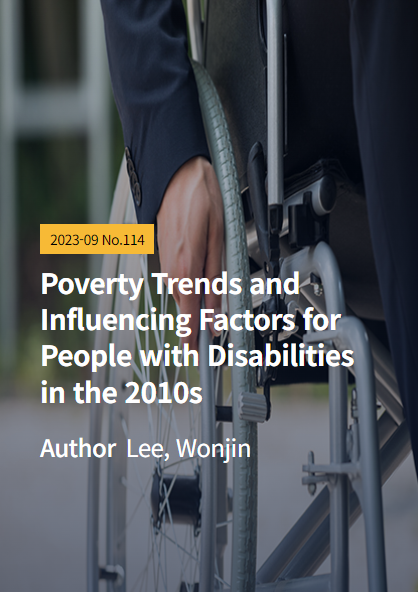Press Release
As Aging Accelerates and the Number of One-Person Households Increases among People with Disabilities, Their Market-Income Poverty Rate Rises
- Date 2023-09-11
- Hits 1,159
Click here to read the full English version of the Research in Brief, No. 2023-09, Vol. 114, "Poverty Trends and Influencing Factors for People with Disabilities in the 2010s."
As Aging Accelerates and the Number of One-Person Households Increases among People with Disabilties, Their Market-Income Poverty Rate Rises
■The average annual disposable income for disabled people was 24.37 million won, around 70 percent of the average for non-disabled people; only 15 percent of disabled people earned on their own a market income equal to or above the poverty line (2020).
■The rise in the market-income poverty rate for disabled people can be attributed to changes in their sociodemographic composition, including aging, an increasing share of one-person households, and a declining proportion of disabled individuals cohabiting with non-disabled working-age family members.
■The short work histories, unstable employment, and resulting low participation in the National Pension among people with disabilities will negatively affect their poverty levels in old age, which is a concern that prompts us to consider how to provide old-age income protection for people with idsabilities within the overall old-age income protection system.
※ Please note that this brief is a summary of the findings of research conducted by KIHASA, and does not contain any government-approved statistics.
※ This brief is a summary of "A Study on the Causes of Changes in Income Distribution and the Effect of Income Security for Persons with Disabilties," by Oh Ukchan, et al. (2022).
KIHASA has published the Health and Welfare Issue and Focus, No. 440, "Poverty Trends and Influencing Factors for People with Disabilities in the 2010s." The lead researcher is Lee Won-jin, Head of the Center for Research on Basic Social Protection, KIHASA.
※ Market-income poverty rate: the ratio of the number of people whose market income, which includes earned income, business income, property income, and private transfer income, is below the poverty line.
Dr. Lee says, "There is no shortage of information on corss-sectional characteristics of income and poverty among people with disabilities. They are found to have less income and higher inequality and poverty rates compared to people without disabilities. Their income levels and poverty rates are affected mostly by their ecoomic activities and income protection programs."
"Time-series analysis of income and poverty among disabled people is in short supply. There do exist a few studies that analyzed the income and poverty of the population with disabilities, but they are primarily trend analyses of income distribution based on panel survey data. This study examines trends in poverty rates among people with disabilities in the 2010s and their influencing factors using the Suvey of Household Finances and Living Conditions," Dr. Lee said.
Main Points of the Brief
■Our analysis of trends in the poverty rate and their influencing factors, conducted using data from the Survey of Household Finances and Living Conditions, revealed that the disposable-income poverty rate for disabled persons declined from 47.0 percent in 2012 to 43.0 percent in 2016. In the years 2016 through 2020, a period examined based on combined data―survey data supplemented with administrative records―the disposable-income poverty rate declined from 40.7 percent to 39.6 percent.
■Despite the continuous expansion of public transfers, disabled people did not see their disposable-income poverty rate fall all that much because of the increase in their market-income poverty rate.
■Our in-depth examination revealed that the rise in the market-income poverty rate among disabled people can be attributed to changes in their sociodemographic composition. These changes included aging, an increasing share of one-person households, and a declining proportion of disabled individuals cohabitating with non-disabled family members.


